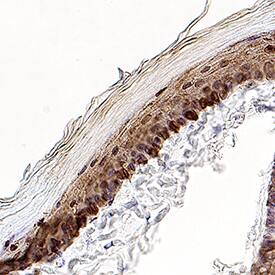Mouse Galectin-7 Antibody
R&D Systems, part of Bio-Techne | Catalog # AF1304


Key Product Details
Species Reactivity
Validated:
Cited:
Applications
Validated:
Cited:
Label
Antibody Source
Product Specifications
Immunogen
Ser2-Phe136
Accession # AAK29385
Specificity
Clonality
Host
Isotype
Scientific Data Images for Mouse Galectin-7 Antibody
Detection of Galectin-7 in Mouse Skin.
Galectin-7 was detected in immersion fixed paraffin-embedded sections of mouse skin using Goat Anti-Mouse Galectin-7 Antigen Affinity-purified Polyclonal Antibody (Catalog # AF1304) at 1 µg/ml for 1 hour at room temperature followed by incubation with the Anti-Goat IgG VisUCyte™ HRP Polymer Antibody (Catalog # VC004) or the HRP-conjugated Anti-Goat IgG Secondary Antibody (Catalog # HAF109). Before incubation with the primary antibody, tissue was subjected to heat-induced epitope retrieval using VisUCyte Antigen Retrieval Reagent-Basic (Catalog # VCTS021). Tissue was stained using DAB (brown) and counterstained with hematoxylin (blue). Specific staining was localized to the cytoplasm and nucleus. View our protocol for IHC Staining with VisUCyte HRP Polymer Detection Reagents.Applications for Mouse Galectin-7 Antibody
Immunohistochemistry
Sample: Immersion fixed paraffin-embedded sections of mouse skin
Western Blot
Sample: Recombinant Mouse Galectin-7 (Catalog # 1304-GA)
Formulation, Preparation, and Storage
Purification
Reconstitution
Formulation
*Small pack size (-SP) is supplied either lyophilized or as a 0.2 µm filtered solution in PBS.
Shipping
Stability & Storage
- 12 months from date of receipt, -20 to -70 °C as supplied.
- 1 month, 2 to 8 °C under sterile conditions after reconstitution.
- 6 months, -20 to -70 °C under sterile conditions after reconstitution.
Background: Galectin-7
The galectins constitute a large family of carbohydrate-binding proteins with specificity for N-acetyl-lactosamine-containing glycoproteins. At least 14 mammalian galectins, which share structural similarities in their carbohydrate recognition domains (CRD), have been identified. The galectins have been classified into the prototype galectins (-1, -2, -5, -7, -10, -11, -13, -14), which contain one CRD and exist either as a monomer or a noncovalent homodimer; the chimera galectins (Galectin-3) containing one CRD linked to a nonlectin domain; and the tandem-repeat galectins (-4, -6, -8, -9, -12) consisting of two CRDs joined by a linker peptide. Galectins lack a classical signal peptide and can be localized to the cytosolic compartments where they have intracellular functions. However, via one or more as yet unidentified non-classical secretory pathways, galectins can also be secreted to function extracellularly. Individual members of the galectin family have different tissue distribution profiles and exhibit subtle differences in their carbohydrate-binding specificities. Each family member may preferentially bind to a unique subset of cell-surface glycoproteins (1‑4).
Mouse Galectin-7 is a prototype monomeric galectin. It is expressed in stratified epithelia and is significantly down-regulated in squamous cell carcinomas. Galectin-7 is a pro-apoptotic protein that is highly induced by the tumor suppressor protein p53. It functions intracellularly upstream of JNK activation to enhance cytochrome c release during apoptosis (5). Galectin-7 may also be involved in cell-cell and cell-matrix interactions and exogenous galectin has been found to accelerate the re‑epithelialization of wounds (6).
References
- Rabinovich, A. et al. (2002) TRENDS in Immunol. 23:313.
- Rabinovich, A. et al. (2002) J. Leukocyte Biology 71:741.
- Hughes, R.C. (2002) Biochimie 83:667.
- R&D Systems' Cytokine Bulletin, Summer (2002).
- Kuwabara, I. et al. (2002) J. Biol. Chem. 277:3487.
- Cao, Z. et al. (2002) J. Biol. Chem. 277:42299.
Alternate Names
Gene Symbol
UniProt
Additional Galectin-7 Products
Product Documents for Mouse Galectin-7 Antibody
Product Specific Notices for Mouse Galectin-7 Antibody
For research use only